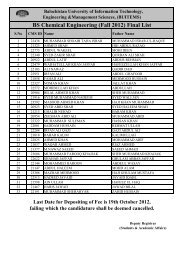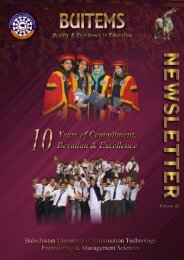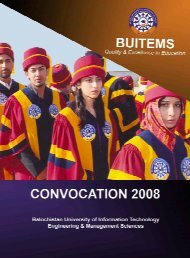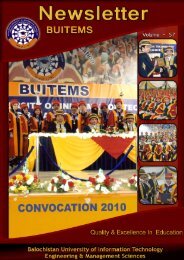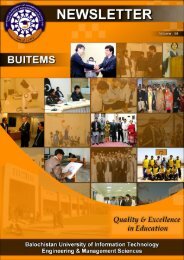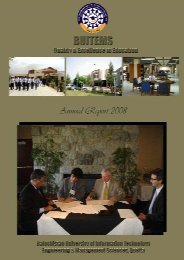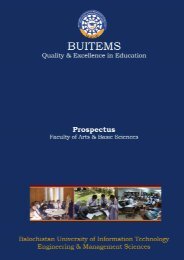BUITEMS
Research Journal - buitems
Research Journal - buitems
- No tags were found...
You also want an ePaper? Increase the reach of your titles
YUMPU automatically turns print PDFs into web optimized ePapers that Google loves.
<strong>BUITEMS</strong><br />
Quality & Excellence in Education<br />
Comparative Genome/Proteome Analysis of Four Serotypes of<br />
Dengue Virus Using Bioinformatics Tools<br />
1 1 1 2 1<br />
Ayesha Arsha, Muhammad Naeem Shahwani, Asma Yousufzai, Fazal-ur-Rehman, Muhammad Asif,<br />
1<br />
Nazeer Ahmed *<br />
1<br />
Department of Biotechnology and Informatics, Balochistan University of Information Technology,<br />
2<br />
Engineering and Management Sciences, Quetta, Department of Microbiology, University of<br />
Balochistan, Quetta<br />
Abstract<br />
Dengue viral infections pose threat to almost half of the world’s population health. The recent outbreak<br />
of dengue fever in Pakistan has invited attention of the scientific community to attempt devising ways<br />
and means and initiating programs controlling this menace. This work is also a step forward in the same<br />
direction. Utilizing different in-silico approaches like CLC Bio workbench, Protparam and Virus mploc<br />
comparative analysis of the full length genome and proteome of dengue virus serotypes was performed.<br />
All the four serotypes exhibited high level of similarities both at genome and proteome level. However,<br />
variations still existed though insignificant. Concerning prediction of sub-cellular localization of viral capsid,<br />
envelop and membrane glycoprotein in the host cell, all three proteins in four serotypes were shown to<br />
target endoplasmic reticulum. Endoplasmic reticulum hosting the viral structural proteins emerges as the<br />
pivot of the future studies aiming controlling dengue infections.<br />
Key words: Dengue serotypes – in-silico-subcellular localization- Genome-Bioinformatics-Proteome<br />
Corresponding author’s email: (nazirdurrani@yahoo.com)<br />
INTRODUCTION<br />
The mysterious viruses are small, infectious,<br />
obligate intracellular parasites solely relying<br />
on host cells for their existence as they lack<br />
the fundamental biochemical machinery<br />
(Koonin et al. 2006). Although Viruses are<br />
one of the most important biological entities<br />
on the earth, still very limited understanding<br />
is there of both the number of virus species<br />
and the diversity of viral genes and genomes.<br />
It is however, beyond doubt that they infect<br />
almost all forms of life, including bacteria,<br />
archaea and eukaryotes from plants to<br />
humans to fungi (Prangishvili et al. 2006).<br />
Among various viral infections, Dengue<br />
infection has been observed to cause havoc<br />
every now and then putting approximately,<br />
40% of the world population at risk. The<br />
estimated figure of dengue infections is<br />
50-100 million people worldwide (WHO<br />
2012). Dengue virus (DENV), which is a<br />
mosquito-borne flavivirus causes a wide<br />
range of diseases in humans, from a selflimited<br />
Dengue fever, to a life-threatening<br />
syndrome called Dengue Hemorrhagic Fever<br />
(DHF). There are four antigenically different<br />
serotypes of the virus: DENV-1, DENV-2,<br />
DENV-3 and DENV-4. within the Flavivirus<br />
genus of the family Flaviviridae (van der Most<br />
et al. 1996) All four serotypes cause dengue<br />
fever (DF), and occasionally the potentially<br />
fatal dengue hemorrhagic fever (DHF) and<br />
dengue shock syndrome (DSS)(Melo et al.<br />
2007). Despite many ongoing vaccine<br />
development programs, no prophylactic<br />
vaccine is currently available to prevent<br />
infection of DENV and the most effective<br />
protective measures are those that avoid<br />
mosquito bites. Precedents for successful<br />
vaccines exist against Flaviviruses (FV) like<br />
the one against yellow fever but vaccine<br />
design for other FV seems more complicated<br />
(Adams and Boots 2006; Seligman and<br />
Gould 2004; Thomas et al. 2006). For<br />
example, a primary infection with one strain<br />
of DV may predispose an individual to<br />
Dengue Hemorrhagic Fever, a more severe<br />
disease, if infected subsequently with a<br />
different DV strain. It is thus critically<br />
important to distinguish the common features<br />
of these viruses, as well as differences that<br />
may be associated with lethality.<br />
This work aims at comparative analysis of the<br />
genomes and proteomes of all four serotypes<br />
of dengue virus with the purpose of finding<br />
the similarities and differences among all four<br />
serotypes. Similarities/differences at both<br />
DNA and amino acid level along with<br />
21



